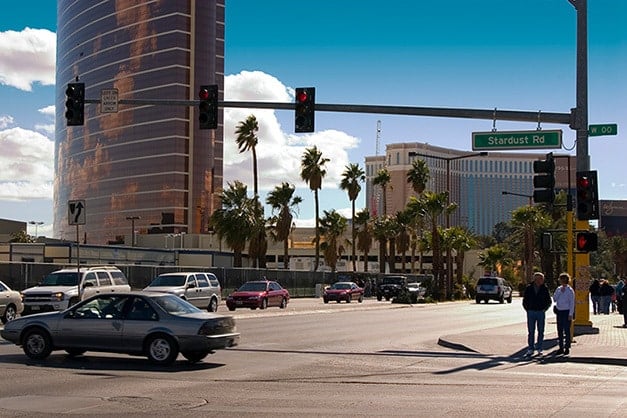Las Vegas has cemented itself as the world’s most iconic gambling city. Even though places like Macau make more money, there’s no doubt that Las Vegas is more recognizable. “Sin City” has become a fixture of popular culture, being depicted in countless songs, movies, and other forms of media.
Despite being a relatively young city, Vegas has had its fair share of evolution. Many of its first casinos have been demolished to make way for new projects, leaving behind their rich histories. Today, we’ll cover one of those classic Vegas establishments: The Stardust Hotel and Casino.
Casino Overview
The Stardust Hotel and Casino was one of Vegas’ most iconic resorts. The largest hotel in the world when it was established, it was the brainchild of bootlegger and entrepreneur Tony Cornero.
One of the most memorable parts about the Stardust was its connection to the mob. For years, the casino’s ownership bounced back and forth between racketeers and bootleggers. It became the mob’s gem, generating untold amounts of cash until it was reclaimed by the Nevada Gaming Control Board in 1983.
The Stardust’s other claim to fame was its gigantic neon sign. At 216 feet long and 37 feet high, the sign was the largest one on the Las Vegas Strip. With 11,000 bulbs and 7,000 feet of tubing, the sign was visible from over three miles away. Even after the resort was demolished, the sign ended up in the boneyard of the Las Vegas Neon Museum.

1954 – 1958: The Birth of the Stardust
In the 50s, gambling was already a well-established industry. You had places like the El Cortez, the Mint, and the Golden Nugget drawing in visitors from all over the country. Vegas saw an annual 8 million visitors, along with $200 million being spent at casinos.
Seeing the potentially lucrative market, ex-bootlegger Tony Cornero had an idea. Having operated offshore casinos before in California, he wanted to appeal to not just high-rollers, but the large number of middle-class people after the war.
Construction for the casino began in 1954, but Cornero passed away from a heart attack just a year later. In 1958, the Stardust’s doors finally opened under the control of Moe Dalitz, a gangster and one of early Vegas’ most influential businessmen.
1958: The Early Years
The Stardust was widely successful, setting numerous records right from the beginning. With a 16,500-square-foot casino and 105-foot-long swimming pool, it held the record for the largest casino in Nevada, largest swimming pool in Nevada, and the largest hotel on the Strip.
The opening ceremony was filled with various celebrities, politicians, and city officials. The star of the night was the French revue production Lido de Paris. Organized by Donn Arden, the show featured costumed showgirls alongside a complex, lift-powered stage.
Despite the grandeur of the opening night, the Stardust lived up to Cornero’s dream of being an affordable option for the middle class. Charging just $6 a night, the hotel provided countless extra amenities that made the $6 fee an absolute steal.
Guests had access to world-class entertainment, a 140-foot bar, a championship golf course, rodeo grounds, a drive-in movie theater, an RV Park, a gambling museum, and so much more. The Lido de Paris became a regular show, quickly gaining fame as one of the must-see attractions on the Las Vegas Strip.

1962-1983: The Stardust’s Golden Era
The Stardust became a hotbed for celebrity activity. Ed Sullivan once broadcasted his CBS variety show on the hotel grounds. Muhammad Ali came there to train for his fight against Floyd Patterson. Siegfried & Roy, the German-American magician duo, got their start as performers in the Stardust.
At the same time, the Stardust was home to enormous amounts of criminal activity. In 1969, the Stardust was sold to the Parvin-Dohrmann Corporation. Five years later, it was sold again to Allen Glick’s Argent Corporation.
Under the Argent corporation, former bookmaker Frank “Lefty” Rosenthal ran the casino. With his authoritative and slightly obsessive management style, the casino became more popular than ever.
Rosenthal was also the first to bring the sportsbook into the casino, which quickly became one of the Stardust’s trademark elements. The pay phones outside the venue were some of the highest-grossing ones in the nation, thanks to gamblers informing their partners about the Stardust’s betting lines.
However, Rosenthal was also an associate of organized crime. By skimming the casino’s profits, he was able to funnel millions of dollars to the Mob. Several Stardust employees were also caught stealing from the Stardust and Fremont casinos on behalf of several Mob bosses.

1983: The Mob is Ousted
In 1983, a federal grand jury indicted 15 people across multiple cities in a casino-skimming conspiracy. That same year, authorities ousted the Mob from the Stardust, giving control of the casino over to Boyd Gaming.
Boyd Gaming operated the casino for 18 months on behalf of Nevada before acquiring it entirely in 1985. In 1999, the Stardust signed Wayne Newton in the biggest entertainment deal in Vegas history, offering him $25 million to live and perform as an in-residence headliner.
21st Century: The Stardust’s Sunset
Unfortunately, the Stardust could not keep up with the changing trends of the modern-day. Vegas leaned away from the middle class, putting more emphasis on billion-dollar mega-resorts.
The Stardust’s final day was November 1, 2006. The last person to ever throw the dice was Hawaiian tourist Jimmy Kumihiro, and customers exited the building in a celebratory conga line.
On March 13, 2007, the Stardust was imploded in a grand ceremony to make way for Boyd Gaming’s new project, Echelon Palace. While Echelon Palace was never completed due to the Recession, it was eventually bought and turned into Resorts World Vegas, which opened in 2021.

